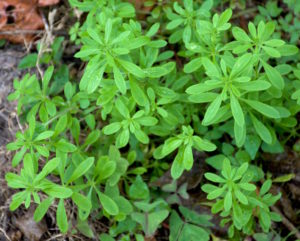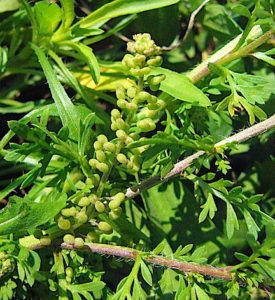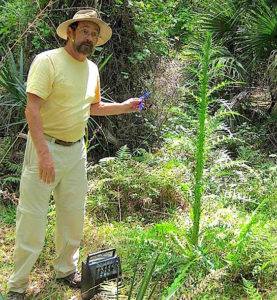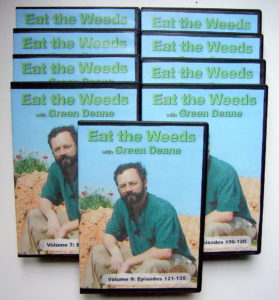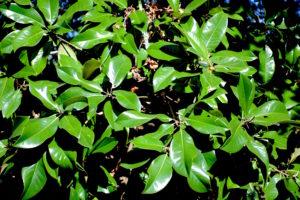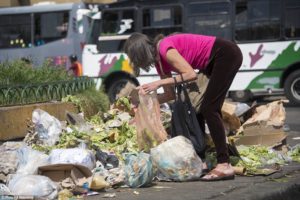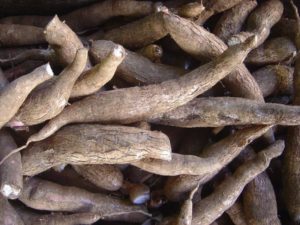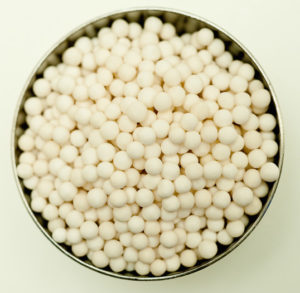
The fibers of the Paper Mulberry bark has been used for thousands of years to make paper and cloth. In the late spring the tree produces edible fruit. Even young leaves are edible cooked. Photo by Green Deane
Cleavers, also called Goosegrass, is a common edible in North America. But instead of late spring or early summer this forageable shows up locally in December. While there are several species two are quite common here, one that is edible and another whose root was used for a red dye (and is not edible as far as I know.) When young Cleavers leaves and stems can be eaten raw and reportedly are good for the lymph system. When older it can be cooked. But at some point it becomes too tough to eat. However, it can be rolled into a bunch and used for a sieve. To read more about “Goosegrass” go here.
Our next seasonal edible, Swinecress, is low-growing and found mostly in lawns. It’s in the mustard family so the general taste is identifiable quickly. Swinecress is among the few plants whose botanical name helps us identify the species. Sometimes a plant will have two names that honor two botanists which doesn’t help us with identification. Swinecress, however, is Coronopus didymus. Coronopus means Raven Foot, or we would say crow foot. To some, or at least the naming botanist, the leaf resembles a crow’s foot. And while that might be so it is the Didymus part that makes the plant easy to identify. Didymus means two testes and indeed it takes very little imagination to see that imagery in the arrangement of the species seeds. Swinecress is edible raw or cook. To read more about this micro-mustard go here.
What if there were a plant that you can use for several things from making a candle to keep away insects to foamy beer? There is such a shrub, and it’s the Southern Wax Myrtle. The species is heavy with berries now which is good news for the birds that eat them and we humans who use them. There seems to be a heavy drop of berries this year which is necessary if you’re looking to make a smokeless candle that keeps away insects. Otherwise the berries are used as a spice. The shrub’s leaves have more uses. The species does come with a pregnancy warning, however. You can read about the shrub here.
Foraging Classes: Except for hurricanes foraging classes usually are held as scheduled though holidays can also interfere. We’re hungry when we are cold and wet so foraging classes are held when it is wet and when it is cold.
Saturday, January 7th, Blanchard Park, 10501 Jay Blanchard Trail, Orlando, FL 32817. 9 a.m. We meet by the tennis courts.
Sunday, January 8th, Bayshore Live Oak Park, 2200 East Lake Road, at Ganyard Road, Port Charlotte. 9 a.m.
Saturday January 14th, Dreher Park, 1200 Southern Blvd., West Palm Beach, 33405. 9 a.m. We meet north of the science center.
Sunday, January 15th, Wickham Park: 2500 Parkway Drive, Melbourne, FL 32935-2335. 9 a.m. We meet at the dog park inside the park.
To learn more about the classes, go here.
Now’s the time to make sure you have a place at the sixth Florida Herbal Conference in February. Because you are a reader of this newsletter you can also get $30 off your registration. And if you register before the end of the year you get an additional $25 discount. That’s a total of $55 off the usual registration fee if you sign up before January 1st and use the registration code GREENDEANE. To read more about the conference and to register go here. This will be my sixth year attending the festival teaching about wild edible plants. There will be many herbal teachers from around the state and nation. Featured keynote speakers are Deb Soule and Guido Mase. The conference’s numerous classes range from Clinical Herbalism to Garden Medicine. Recreational activities at the Lake Wales site include yoga, singing, drumming, and canoeing. Ms. Imani and Beautiful Chorus will provide music. A wide array of artisans and crafters will also have booths at the conference. Camping is included in registration, and indoor cabin lodging and weekend meal plans are also available. Proceeds of the conference will benefit United Plant Savers. Again, to read about and register go here.
All of Green Deane’s videos are available for free on You Tube. They do have ads on them so every time you watch a Green Deane video I get a quarter of one cent. Four views, one cent. Not exactly a large money-maker but it helps pays for the newsletter. If you want to see the videos without ads and some in slightly better quality you can order the DVD set. It is nine DVDs with 15 videos on each. They make a good Christmas gift. Many people want their own copy of the videos or they have a slow service and its easier to order then to watch them on-line. They make a good gift for that forager you know. Individual DVDs can also be ordered. You can order them by clicking on the button on the top right of this page or you can go here. If that link is not working — there have been some site issues — you can use a donation link and email me your order and address.
Want to identify a plant? Looking for a foraging reference? Do you have a UFO, an Unidentified Flowering Object you want identified? On the Green Deane Forum we chat about foraging all year. And it’s not just about warm-weather plants or just North American flora. Many nations around the world share common weeds so there’s a lot to talk about. There’s also more than weeds. The reference section has information for foraging around the world. There are also articles on food preservation, and forgotten skills from making bows to fermenting food. You can join the forum by clicking on the button on the upper right hand side of this page.
People forage for many reasons. For some it’s new flavors and textures 0r nutritional combinations. Others want unmodified plants without exposure to agricultural chemicals. For some it is just fun. Foraging is treasure hunting for adults. And there are survivalists who want to find food when traditional sources of food are scarce. Shortage of food was highlighted this week in a story in the New York Times.
Venezuela was a rich nation with a lot of oil. Socialist governments have run the country into the economic ground and people are starving. There are reports of parents giving away children because they can’t feed them. Cannibalism has been verified in at least one prison. Even though the population is not long removed from the forest most people have lost the skill to forage. A family in the eastern city of Maturin that had not eaten for three days harvested some Bitter Cassava from an abandoned field. Unfortunately they processed it improperly (Method of Preparation) and a boy in the family, Kevin Lugo, died from cyanide poisoning.
Commercially raised cassava (Yuca, YOU-kah*) has been bred to have minimal amounts of cyanide which is why it is called Sweet Cassava. Small farmers in Venezuela, however, prefer to raise higher-in-cyanide Bitter Cassava because people don’t steal it as readily as Sweet Cassava. Bitter Cassava processing includes peeling (83 percent of the toxin is in the peeling) washing, partial drying, grating/chipping, fermentation for several days, pressing and complete drying. Fermentation is a critical step. (I suspect this is also why cyanid-carrying Coontie roots must be fermented.) In the Bitter Cassava sugar and cyanide are bound together in cyanogenic glucocides which happens in many species. The fermentation separates the sugar from the cyanide. This allows the freed cyanide to be washed away. This is also why chipping, or better, grating is necessary. The more surface area exposed the more cyanide is released.
The family didn’t ferment the Bitter Cassava. They peeled and dried it. The entire family became ill. The boy was taken to the hospital but because of crowding did not get medical attention for many hours and then medicine and intravenous fluids were not available. Lugo died on his 16th birthday. Knowing what to eat is important as is knowing what not to eat. And with some species Method of Preparation is crucial. *Yucca (YUCK-ka is a totally different species and does not have edible roots.)
This is Newsletter 238.
If you would like to donate to Eat The Weeds please click here.

